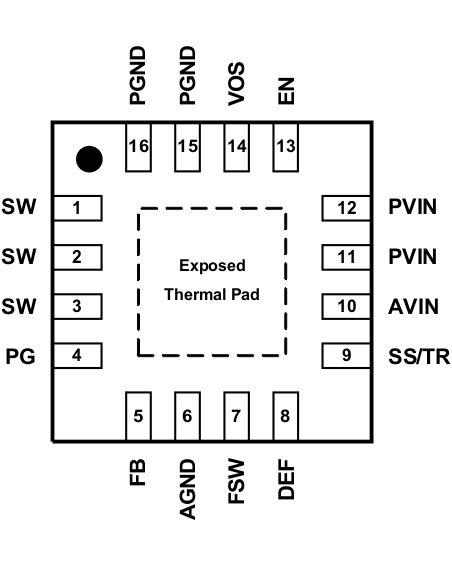JAJSEC9D May 2014 – January 2018 TPS6213013A-Q1 , TPS62130A-Q1 , TPS62133A-Q1
PRODUCTION DATA.
- 1 特長
- 2 アプリケーション
- 3 概要
- 4 改訂履歴
- 5 Device Comparison Table
- 6 Pin Configuration and Functions
- 7 Specifications
- 8 Parameter Measurement Information
-
9 Detailed Description
- 9.1 Overview
- 9.2 Functional Block Diagram
- 9.3
Feature Description
- 9.3.1 Pulse Width Modulation (PWM) Operation
- 9.3.2 Power Save Mode Operation
- 9.3.3 100% Duty-Cycle Operation
- 9.3.4 Enable / Shutdown (EN)
- 9.3.5 Soft Start / Tracking (SS/TR)
- 9.3.6 Current Limit And Short Circuit Protection
- 9.3.7 Power Good (PG)
- 9.3.8 Pin-Selectable Output Voltage (DEF)
- 9.3.9 Frequency Selection (FSW)
- 9.3.10 Under Voltage Lockout (UVLO)
- 9.3.11 Thermal Shutdown
- 9.4 Device Functional Modes
-
10Application and Implementation
- 10.1 Application Information
- 10.2
Typical Application
- 10.2.1
TPS62130A-Q1 Point-Of-Load Step Down Converter
- 10.2.1.1 Design Requirements
- 10.2.1.2
Detailed Design Procedure
- 10.2.1.2.1 Custom Design With WEBENCH® Tools
- 10.2.1.2.2 Programming The Output Voltage
- 10.2.1.2.3 External Component Selection
- 10.2.1.2.4 Inductor Selection
- 10.2.1.2.5 Output Capacitor
- 10.2.1.2.6 Input Capacitor
- 10.2.1.2.7 Soft Start Capacitor
- 10.2.1.2.8 Tracking Function
- 10.2.1.2.9 Output Filter And Loop Stability
- 10.2.1.3 Application Curves
- 10.2.1
TPS62130A-Q1 Point-Of-Load Step Down Converter
- 10.3 System Examples
- 11Power Supply Recommendations
- 12Layout
- 13デバイスおよびドキュメントのサポート
- 14メカニカル、パッケージ、および注文情報
パッケージ・オプション
デバイスごとのパッケージ図は、PDF版データシートをご参照ください。
メカニカル・データ(パッケージ|ピン)
- RGT|16
サーマルパッド・メカニカル・データ
発注情報
6 Pin Configuration and Functions
Pin Functions
| PIN(1) | I/O | DESCRIPTION | |
|---|---|---|---|
| NO. | NAME | ||
| 1,2,3 | SW | O | Switch node, which is connected to the internal MOSFET switches. Connect inductor between SW and output capacitor. |
| 4 | PG | O | Output power good (High = VOUT ready, Low = VOUT below nominal regulation) ; open drain (requires pull-up resistor) |
| 5 | FB | I | Voltage feedback of adjustable version. Connect resistive voltage divider to this pin. It is recommended to connect FB to AGND on fixed output voltage versions for improved thermal performance. |
| 6 | AGND | Analog Ground. Must be connected directly to the Exposed Thermal Pad and common ground plane. | |
| 7 | FSW | I | Switching Frequency Select (Low=2.5MHz, High=1.25MHz for typical operation)(2) |
| 8 | DEF | I | Output Voltage Scaling (Low = nominal, High = nominal + 5%)(2) |
| 9 | SS/TR | I | Soft-Start / Tracking Pin. An external capacitor connected to this pin sets the internal voltage reference rise time. It can be used for tracking and sequencing. |
| 10 | AVIN | I | Supply voltage for control circuitry. Connect to same source as PVIN. |
| 11,12 | PVIN | I | Supply voltage for power stage. Connect to same source as AVIN. |
| 13 | EN | I | Enable input (High = enabled, Low = disabled)(2) |
| 14 | VOS | I | Output voltage sense pin and connection for the control loop circuitry. |
| 15,16 | PGND | Power Ground. Must be connected directly to the Exposed Thermal Pad and common ground plane. | |
| Exposed Thermal Pad | – | Must be connected to AGND (pin 6), PGND (pin 15,16) and common ground plane(3). Must be soldered to achieve appropriate power dissipation and mechanical reliability. | |
(1) For more information about connecting pins, see Detailed Description and Application and Implementation sections.
(2) An internal pull-down resistor keeps logic level low, if pin is floating.
(3) See Figure 55.
